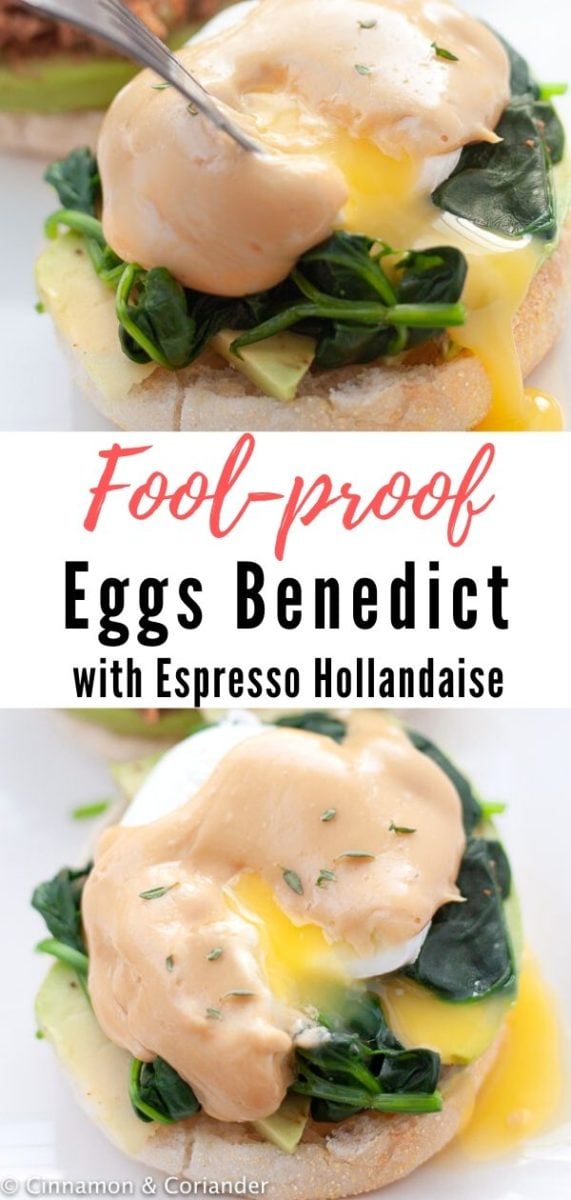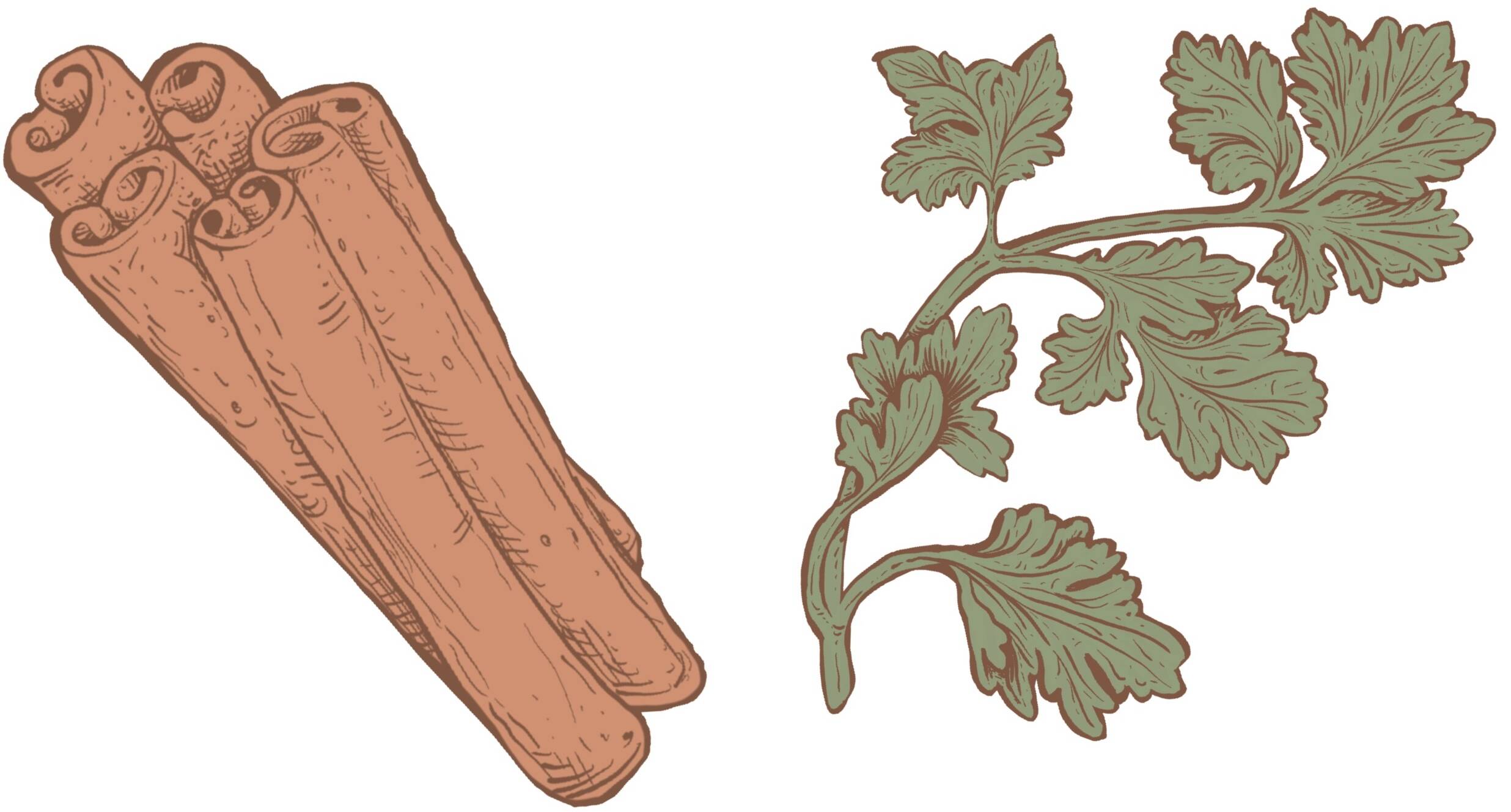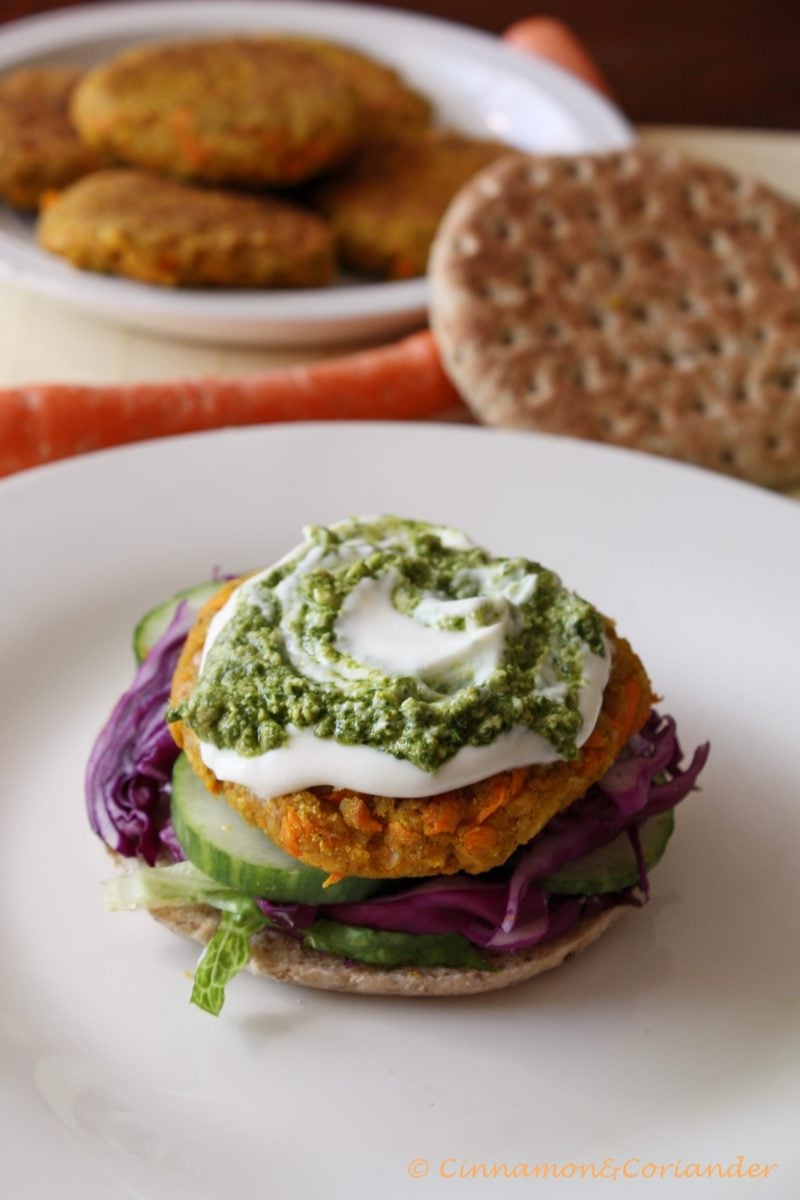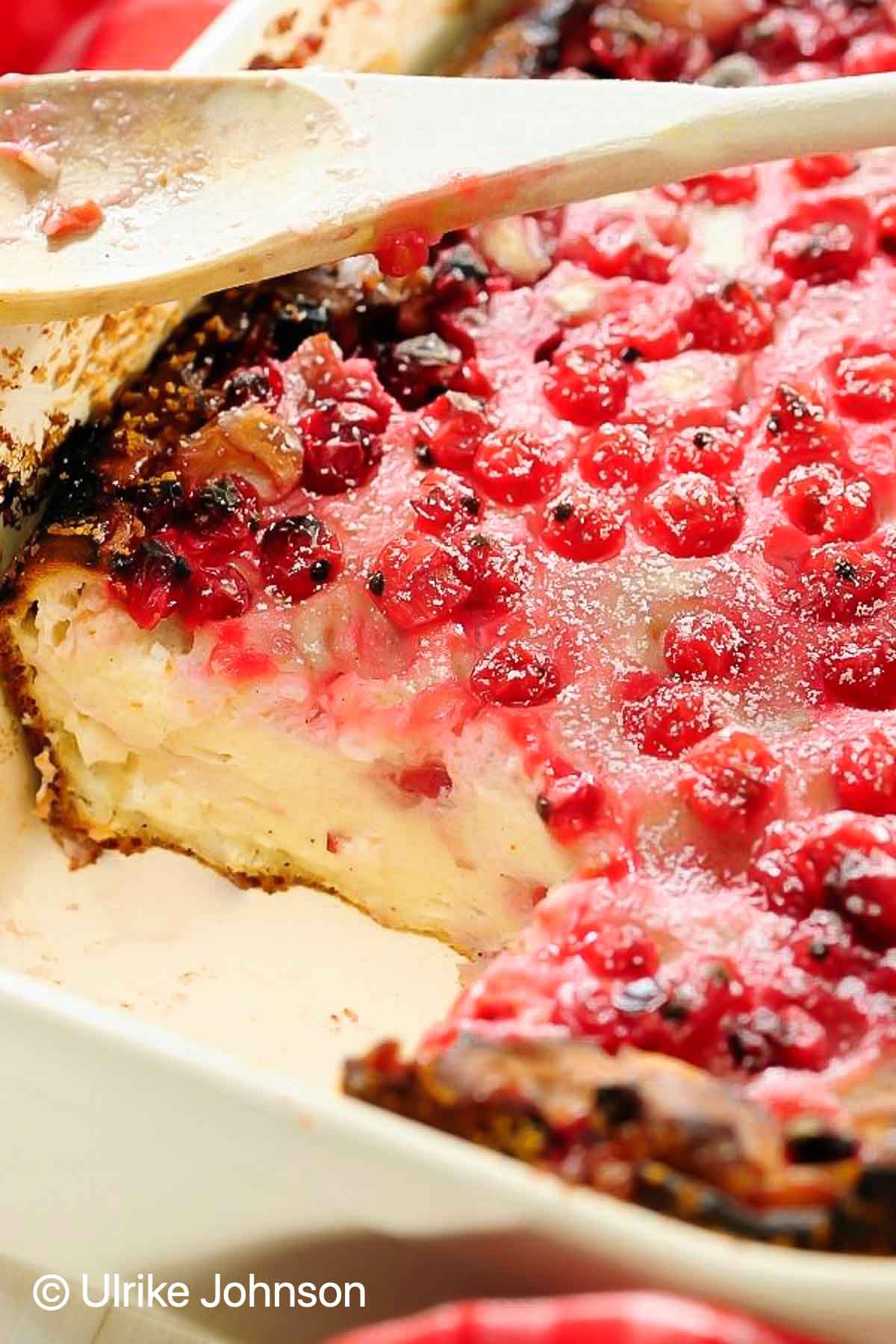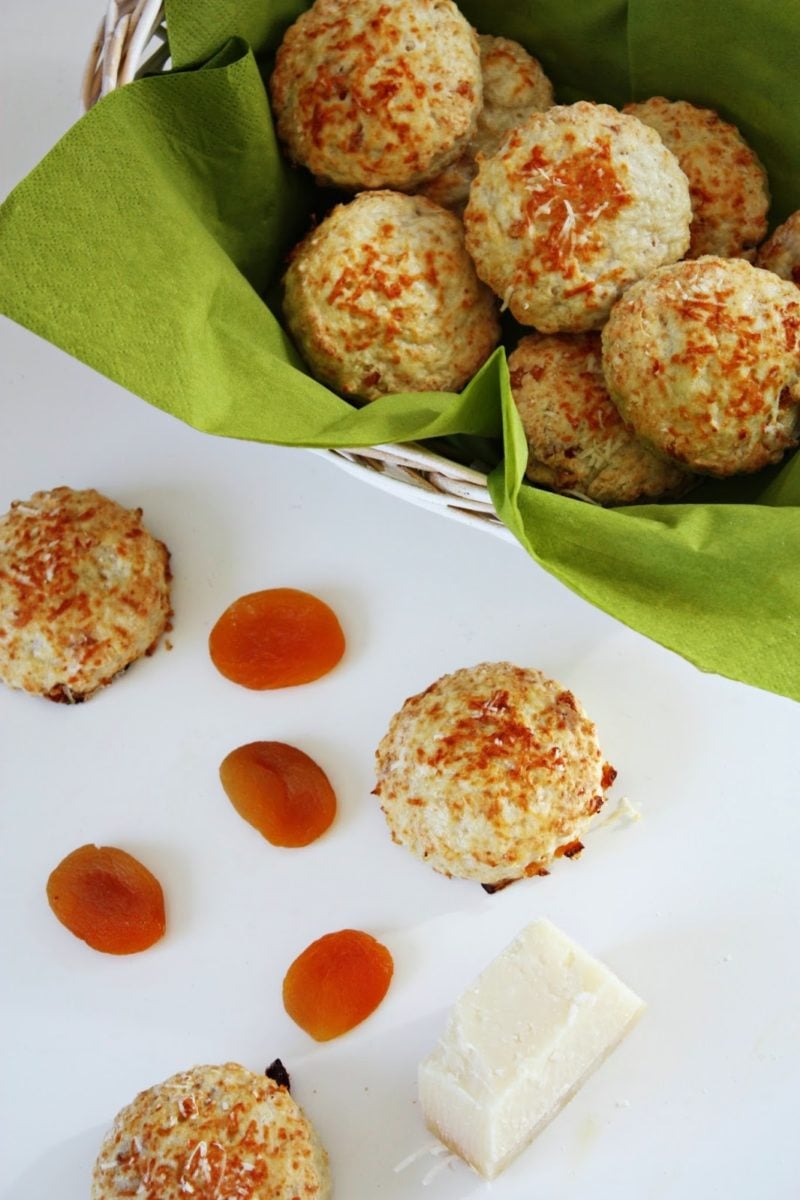Best Eggs Benedict Recipe with Spinach & Immersion Blender Espresso Hollandaise
Dieser Beitrag ist auch verfügbar auf:
![]() Deutsch (German)
Deutsch (German)
The best eggs benedict recipe with tips for perfectly poached eggs! Serve them on a toasted English muffin and finish them with my over the top delicious fool-proof espresso hollandaise sauce made with an immersion blender! Breakfast decadence!
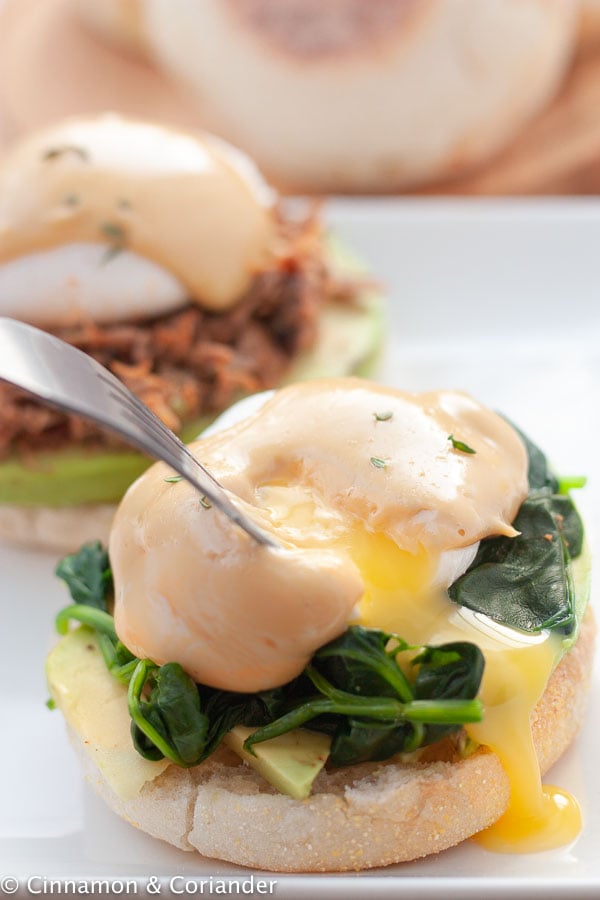
Eggs Benedict, aka the king of breakfast dishes! In this post, you will learn all there is to know to make the best Eggs Benedict at home!
Now, eggs benedict something I don’t make for myself. But sometimes life should be a feast with Eggs Benedict & Hollandaise, strawberries, and sunshine. Or there may be an occasion, such as Valentine’s Day, Easter, Mother’s Day, for which you might want to make a special someone feel especially loved. Eggs Benedict is as special as they come.
For this eggs benedict recipe, I went with an espresso hollandaise, which I find absolutely and utterly perfect. Teamed with espresso, the hollandaise gets a more savory, almost earthy quality you will love. On a side note: The espresso hollandaise goes extremely well with grilled steak, too so save it for bbq season.
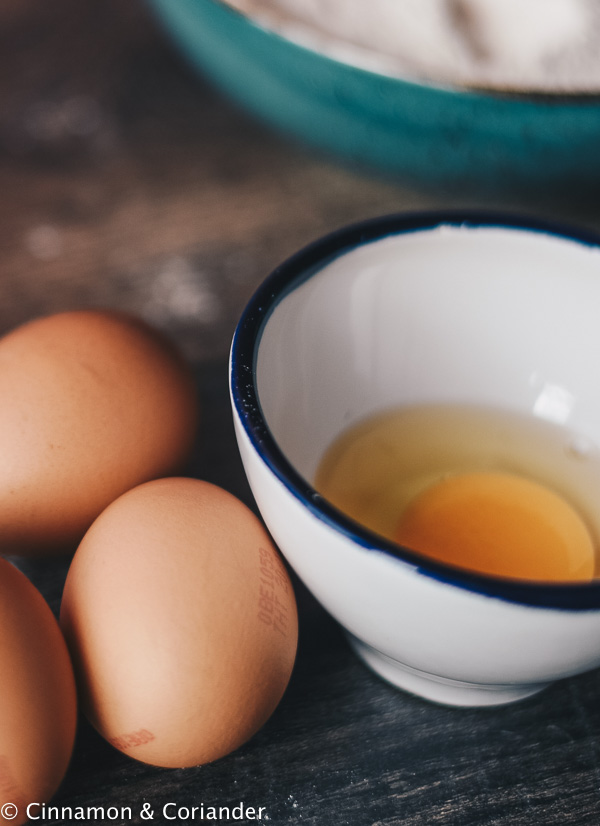
How to poach eggs for making eggs benedict:
First, we need to talk about poaching eggs! This is how you get a perfectly poached egg with a runny yolk and whites that are just firm enough on the outside to contain the oozy, golden yolk. With these tips, you too can learn how to poach an egg perfectly every time!
- Get fresh organic eggs from a happy chicken! They have firmer whites a more vibrant yolk and just hold their shape better.
- Use a big, deep pot that fits at least 4-inches of water.
- Don’t add salt to the water. The egg whites will spread more.
- Add some vinegar to your poaching water to help keep the egg white together. Don’t worry your eggs will not taste like vinegar! You have to add quite a bit to have any vinegar taste transfer to the poached egg. I add a good splash of white vinegar.
- Crack your eggs into individual ramekins before pouring the egg into the hot water. That way you make sure you have an unbroken yolk and no shells in the egg. Plus you can more easily pour the egg in one swift move.
- When you crack an egg you might notice a firmer white and a more liquidy white. The liquidy white will create all those white wispies. By adding the egg to a fine-mesh sieve we remove the thin white stuff, leaving only the firmer white to envelop the yolk.
- Drop them in a swirling vortex of water. This helps to create a more spherical shape as the egg white wraps around itself. This only works if you are cooking one egg after another. If you’re cooking more than one poached egg – don’t bother.

Can you poach eggs ahead of time?
Absolutely! After the eggs have finished poaching, just place them in an ice-water bath and store them in the fridge for 4-5 days.
When you want to serve them, just add some hot water to a small bowl or cup and add the poached egg until it’s just warmed up which should take only about 20-30 seconds.
How to make the perfect hollandaise sauce using an immersion blender:
There’s a super-easy way to make the perfect sauce hollandaise at home that requires no whisking, no water bath and produces a hollandaise that’s just as smooth, rich and decadent as one made with traditional methods. This quick hollandaise, emulsified with an immersion blender, is absolutely foolproof.
Making immersion blender Hollandaise is almost identical to making mayo, using butter instead of oil. The high speed of the blender blades creates a perfect emulsion with the egg yolks.
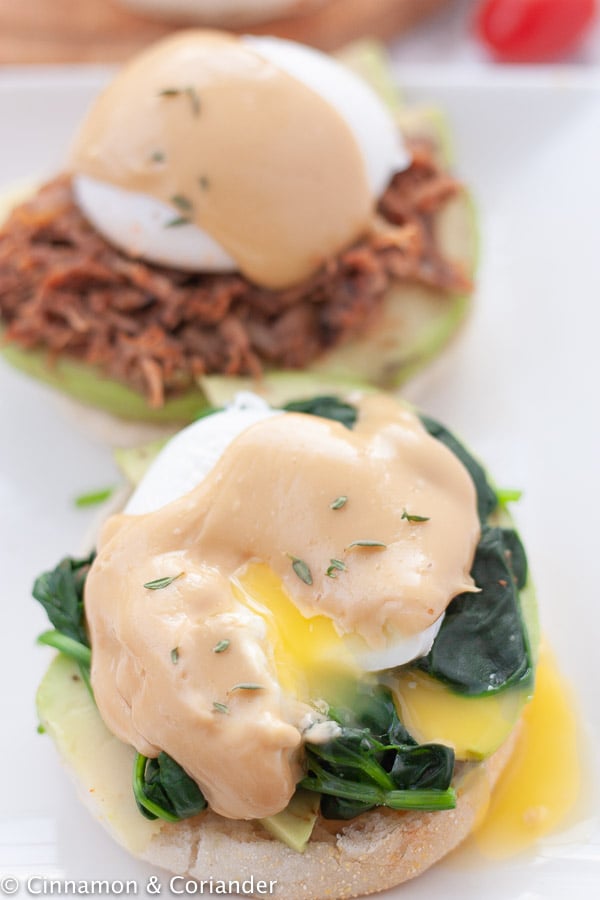
Simply put everything except the butter to the container and blend. Then stream in the hot butter while blending, until it thickens. Done!
When using the immersion blender method, make sure you use the right size jar. The head of your blender should just fit inside.
What to serve with eggs benedict:
What you need for the perfect eggs benny is a golden brown, toasted English muffin, and some toppings like sauteed spinach, pulled pork, avocado, or some thick slices of flavorful Canadian bacon!
Some people serve eggs benedict with hash browns but I like to have a side of fruit to help balance the saltiness and richness that comes from the egg and the hollandaise. Pineapples and strawberries are especially nice and pair so well with bacon.
Sometimes I’ll make a vegetarian benedict and swap the meat for mashed or sliced avocado.

More delicious breakfast recipes you will love:
- Iranian Lima Beans Stew with Eggs and Dill
- Vegan Almond Milk Pancakes
- Fried Oatmeal with Cranberry Curd
- Thomas Keller’s Famous Brioche
★ Did you make and love this eggs benedict recipe? Give it your review below! And make sure to share your creations by tagging me on Instagram!
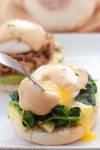
Eggs Benedict with Homemade Espresso Hollandaise
The best eggs benedict recipe with tips for perfectly poached eggs! Serve them on a toasted English muffin and finish them with my over the top delicious fool-proof espresso hollandaise sauce made with an immersion blender! Breakfast decadence!
Ingredients
For the eggs
- 2 tsp vinegar
- 4 fresh eggs
For the espresso hollandaise
- 1 egg yolk
- 1 pinch salt
- 1/2 tsp instant espresso powder
- 1/2 tsp maple syrup
- 1 tsp fresh lemon juice
- 1/2 cup butter 120 g
Topping
- spinach
- avocado
- smoked salmon
- bacon
For assembling
- 2 English muffins toasted and buttered
Instructions
-
Prepare a big bowl with ice water.
Fill a big bot with water and bring to a boil, then turn down the temperature. Add the vinegar. The water should not be boiling but be very hot, about 185 F – 192F ( 85 – 89 Celsius) is perfect.
-
Crack the egg in a fine-mesh sieve (placed over a small bowl) and remove the liquidy whites. Transfer the egg to a small ramekin or bowl.
-
Stir the pot to create a vortex. Pour the ramekin with the egg into the middle of the vortex and set a timer for 3 to 4 minutes.
-
Once the egg is done, use a slotted spoon to remove the poached egg. Dab with a paper towel to remove excess water and eat immediately or place in ice water if you want to move on and make your own hollandaise. (see post for notes on how to reheat your poached egg)
For the hollandaise
-
Prep all toppings. Take out your immersion blender and a high container. The head of the immersion blender should just fit, but it should be rather thin and high.
-
Whisk espresso powder with 1 tsp hot water, maple syrup, and lemon juice until the powder is dissolved.
-
Melt the butter in a small pan on medium heat, let come to a bubble, and wait until it stops foaming. This should happen at around 2019F or 104 C. Sway the pot a little. Add melted butter to a small can - something that allows you to pour it in a steady thin stream.
-
Add egg yolk and salt to the container along with the espresso mix. Quickly blend together egg yolks and espresso mix. With the immersion blender running, pour in the hot butter in a thin stream. The hollandaise should be thick and shiny now. Pour over the toasted English muffins and eggs (see assembly instructions below).
Assemble
-
Toast English muffins in a toaster or under the broiler. Butter it, if you want.
Now place your toppings (a slice of Canadian bacon, salmon or avocado and spinach) atop each English muffin. Top each with a poached egg and season with salt and pepper. Spoon or pour hollandaise sauce over top, and garnish with fresh herbs and maybe a sprinkling of cayenne pepper.
Recipe Notes
- Get fresh organic eggs from a happy chicken! They have firmer whites a more vibrant yolk and just hold their shape better.
- Use a big, deep pot that fits at least 4-inches of water.
- Don’t add salt to the water. The egg whites will spread more.
- Add some vinegar to your poaching water to help keep the egg white together. Don't worry your eggs will not taste like vinegar! You have to add quite a bit to have any vinegar taste transfer to the poached egg. I add a good splash of white vinegar.
- Crack your eggs into individual ramekins before pouring the egg into the hot water. That way you make sure you have an unbroken yolk and no shells in the egg. Plus you can more easily pour the egg in one swift move.
- When you crack an egg you might notice a firmer white and a more liquidy white. The liquidy white will create all those white wispies. By adding the egg to a fine-mesh sieve we remove the thin white stuff, leaving only the firmer white to envelop the yolk.
- Drop them in a swirling vortex of water. This helps to create a more spherical shape as the egg white wraps around itself. This only works if you are cooking one egg after another. If you’re cooking more than one poached egg – don’t bother.
